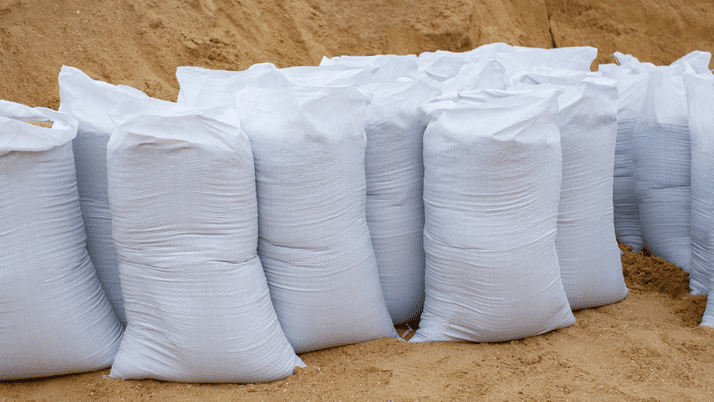
Sandbags are a fundamental tool in construction. Their simplicity belies their incredible versatility, as they can be used in a myriad of ways to address challenges that arise on construction sites. Whether as erosion control products Solano County, weight stabilization, flood prevention, or temporary barriers, sandbags are a cost-effective solution for many common construction scenarios.
In this guide, we’ll dive deep into the practical applications of sandbags in construction, explore their benefits, and highlight why they should be a staple in every contractor’s toolkit. By understanding the value and uses of sandbags, professional contractors can maximize efficiency and tackle projects with greater confidence.
As mentioned, sandbags are a versatile tool for contractors on any site. Some practical uses include:
Erosion control is one of the primary uses of sandbags in construction. Effective erosion and sediment control products are essential. Construction sites often disturb soil, making it vulnerable to water or wind erosion. Sandbags can be strategically placed to:
Prevent water from washing away soil by creating channels or barriers with sandbags.
On sloped terrain, sandbags can hold soil in place, reducing the risk of landslides or soil erosion.
Flooding is a significant concern for contractors, especially in regions prone to storms or heavy rainfall. Sandbags serve as a first line of defense against rising water levels. They can be used to:
Build walls of sandbags to protect structures and equipment from water damage.
Channel water away from critical areas of the construction site.
Sandbags can act as temporary fills in ditches or depressions, preventing water from pooling.
On construction sites, stability is critical, especially for structures or essential equipment for the prepared surveyor that might shift under heavy wind or uneven ground. Sandbags can be used to:
Add weight to scaffolding bases to prevent movement during high winds or vibrations.
Keep tents, signage, or fencing securely in place.
Distribute weight evenly on unstable surfaces.
Sandbags are an excellent resource when pouring concrete. Their moldable nature makes them ideal for creating temporary formwork or supporting existing forms. Contractors can:
Use sandbags as flexible molds for curves or irregular shapes.
Reinforce the edges or seams of traditional formwork to prevent leaks.
Sandbags are commonly employed to protect foundations and trenches during construction. They can:
Support trench walls to ensure safety and maintain structural integrity.
Shield foundation edges from water intrusion or erosion during the building process.
In construction, managing materials and waste is crucial to avoid contamination. Sandbags are often used for:
Create barriers to prevent the spread of spills or debris. Can also be used alongside effective strategies for stabilizing steep hillsides.
Block particulate matter from escaping the site during windy conditions or heavy machinery operation.
Construction projects are unpredictable, and emergencies can arise. Sandbags are invaluable for quick responses to:
Protect ongoing work or equipment from unexpected weather events.
Act as temporary support for damaged walls or barriers.
Fill potholes or stabilize uneven road surfaces temporarily.
Some of the advantages of using sandbags include:
Sandbags are inexpensive compared to other construction materials, making them a budget-friendly option for temporary fixes and preventive measures.
Their lightweight, compact design when empty makes sandbags easy to store and transport. Once filled, they provide the necessary weight and stability for various tasks.
From flood prevention to structural support, the adaptability of sandbags makes them suitable for a wide range of construction needs.
Among modern construction supply products, sandbags are designed to withstand harsh environmental conditions, ensuring they remain functional for extended periods.
Many sandbags are made from biodegradable materials or recycled fabrics, making them a sustainable choice for eco-conscious contractors.
To get the most out of sandbags on your construction site, keep these best practices in mind:
Sandbags should be filled halfway to allow flexibility and ensure they mold effectively to surfaces.
When building barriers, stack sandbags in an overlapping brick pattern for maximum stability.
Anchor sandbags with stakes or tie-downs when using them for long-term applications.
Check sandbags periodically for wear and tear, especially after exposure to harsh weather.
Not all sandbags are created equal and choosing the right type from a reputable distributer like Stevenson Supply & Tractor Co. is critical for successful application. Consider:
Polypropylene sandbags are durable and water-resistant, while burlap bags are biodegradable and suitable for short-term use.
Standard sandbags are 14” x 26”, but larger or smaller sizes may be better for specific tasks.
UV-treated sandbags are ideal for prolonged outdoor use.
The versatility of sandbags in construction cannot be overstated. Their ability to adapt to different scenarios makes them a must-have for any contractor looking to improve efficiency and problem-solving on the job. From preventing costly water damage to ensuring safety during emergencies, sandbags are a dependable and cost-effective resource.
As a professional contractor, having sandbags on hand can save time, reduce costs, and enhance safety across various projects.
At Stevenson Supply & Tractor Co., we understand the importance of reliable tools and materials for your projects. Our high-quality sandbags are designed to meet the rigorous demands of construction professionals. Contact Stevenson Supply & Tractor Co. today or give us a call at (707) 575-3335 to explore our sandbag options and equip your site for success.
President/CEO
Kent Stevenson is the owner and president of Stevenson Supply & Tractor Co., a family-owned equipment and supply company serving Sonoma County and the North Bay agricultural community since 1967. Under Kent’s leadership, the company has expanded from a small tractor dealership into a trusted regional provider of agricultural equipment, hardware, fencing, and repair services.
Kent is known for his deep agricultural knowledge, hands-on approach, and commitment to serving the local farming and vineyard community. His business philosophy blends old-fashioned service with modern efficiency, ensuring every customer—from homeowners to commercial growers—receives honest guidance and reliable equipment solutions.
Stevenson Supply continues to reflect the values Kent grew up with: hard work, integrity, and dedication to supporting the people who keep Sonoma County growing.